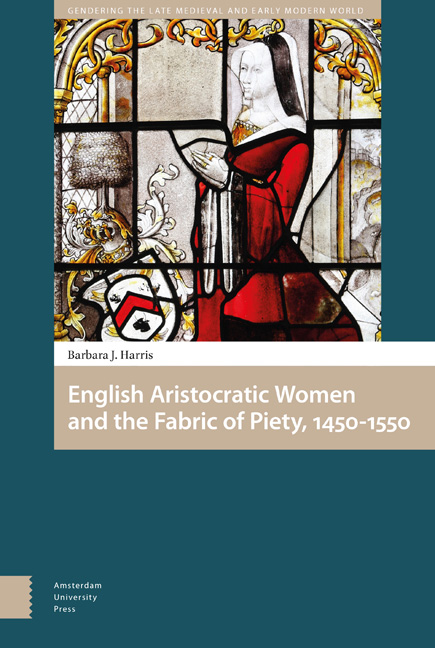Book contents
- Frontmatter
- Dedication
- Contents
- Abbreviations
- Illustrations
- Acknowledgements
- Preface
- Introduction
- 1 Tombs: Honoring the Dead
- 2 Chantries: The Quest for Perpetual Prayers
- 3 Building for the Congregation: Roofs, Aisles, and Stained Glass
- 4 Adorning the Liturgy: Luxury Fabrics and Chapel Plate
- 5 Almshouses and Schools: Prayers and Service to the Community
- 6 Defining Themselves
- 7 Epilogue: Destruction and Survival
- Conclusion
- Appendix 1 Patrons of the Fabric of the Church
- Appendix 2 Patrons of Tombs
- Appendix 3 Location of Tombs in Churches
- Appendix 4 Choice of Burial Companion
- Appendix 5 Women Who Commissioned Chantries
- Appendix 6 Commissions of Stained-Glass Windows
- Appendix 7 Additions or Major Repairs to Churches
- Appendix 8 Bequests of Vestments
- Appendix 9 Patrons of Almshouses or Schools
- Glossary
- Select Bibliography
- Archival Sources
- Index
- Frontmatter
- Dedication
- Contents
- Abbreviations
- Illustrations
- Acknowledgements
- Preface
- Introduction
- 1 Tombs: Honoring the Dead
- 2 Chantries: The Quest for Perpetual Prayers
- 3 Building for the Congregation: Roofs, Aisles, and Stained Glass
- 4 Adorning the Liturgy: Luxury Fabrics and Chapel Plate
- 5 Almshouses and Schools: Prayers and Service to the Community
- 6 Defining Themselves
- 7 Epilogue: Destruction and Survival
- Conclusion
- Appendix 1 Patrons of the Fabric of the Church
- Appendix 2 Patrons of Tombs
- Appendix 3 Location of Tombs in Churches
- Appendix 4 Choice of Burial Companion
- Appendix 5 Women Who Commissioned Chantries
- Appendix 6 Commissions of Stained-Glass Windows
- Appendix 7 Additions or Major Repairs to Churches
- Appendix 8 Bequests of Vestments
- Appendix 9 Patrons of Almshouses or Schools
- Glossary
- Select Bibliography
- Archival Sources
- Index
Summary
Between 1450 and 1550, aristocratic English women played a significant role in rebuilding and beautifying churches that were a major feature of religious life in the period. They commissioned, paid for, and supervised the construction of tombs, altars, chapels, new aisles, porches, and stained-glass windows in their parish churches and other favorite religious institutions. They also donated luxurious vestments and gold and silver crosses and plate to enrich the spectacle of the Mass. In addition, though in smaller numbers, they built and endowed almshouses and schools that served both charitable and religious purposes.
These findings introduce to the historical record a female aristocratic contribution to culture that has not previously been recognized aside from a handful of exceptional cases. While their achievement is unquestionable, assessing it in the context of the period raises two questions: how did their commissions compare to those of their husbands? And were aristocratic Englishwomen unique, or did elite women in other European countries engage in similar patronage?
Aristocratic women were as active as the men of their class in patronizing the enlargement, restoration, and beautification of their parish churches and other religious institutions. The only area where numbers exist to support this conclusion is that of tomb-building. The evidence, which comes from 763 men's and 309 women's wills, indicates that gentlewomen and noble women, the majority of whom were widows, commissioned monuments as often as their husbands in their role as the men's sole executors, co-executors, or overseers. Of the 763 male testators, 523 male testators had surviving wives; and 403, or 77 percent, of them appointed their wives as their sole executors (139), co-executors (249), or overseers (15). Of the sole or principal executors and overseers, 163 commissioned monuments for themselves and/or their husbands. In most of these cases, the women expected to be buried with the men after their own deaths. The majority of the other widows who commissioned tombs were co-executors who probated their husbands’ wills alone. A small number commissioned their own monuments without reference to their spouses. Finally, local historical sources contain evidence of monuments not mentioned in wills. Altogether, these sources indicate that 196 aristocratic women built monuments for themselves and/ or their spouses.
- Type
- Chapter
- Information
- English Aristocratic Women's Religious Patronage 1450-1550 , pp. 151 - 156Publisher: Amsterdam University PressPrint publication year: 2018

